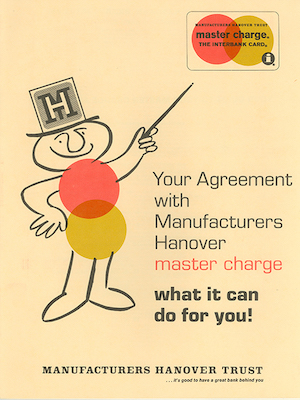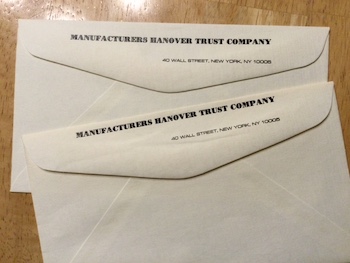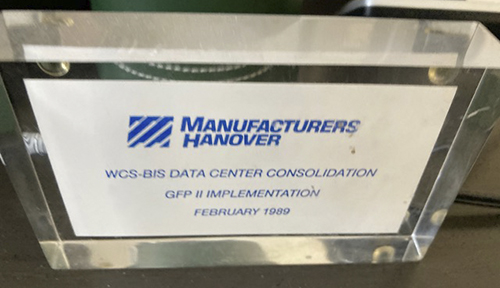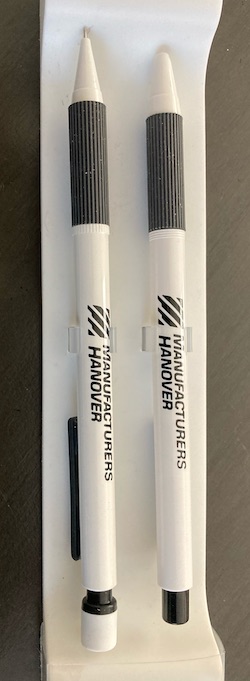MHT/Chemical...Chemical/Chase, Part I
Starting at MHT
Alumni remember their careers (Click here for Part 2)(with date of posting next to name; newest entries on top)
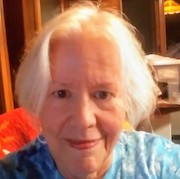 From Penny Quinn (3/15/21): My Mom always spoke with love, of her time with Manufacturers Hanover. She worked at a downtown headquarters office from the mid-1940s until the early 1950s with time off for a couple of babies. I didn't have this same experience, but when she worked for Manufacturers they were "associated" with Hanover, with Manufacturers being the more business type and Hanover being the old money type. In any event, there was a lot of money flowing if you could work the hours they needed. So the banks were next door or at least very close to each other. My Mom described working a full shift and then unlimited overtime. I forget what she did. If Manufacturers didn't have work, she was sent to Hanover. Mine and my sister's (3/23/49 and 3/10/50) birth announcements were in the monthly magazines. I had seen them, but at one point a coworker asked to borrow them and then died before returning them.
From Penny Quinn (3/15/21): My Mom always spoke with love, of her time with Manufacturers Hanover. She worked at a downtown headquarters office from the mid-1940s until the early 1950s with time off for a couple of babies. I didn't have this same experience, but when she worked for Manufacturers they were "associated" with Hanover, with Manufacturers being the more business type and Hanover being the old money type. In any event, there was a lot of money flowing if you could work the hours they needed. So the banks were next door or at least very close to each other. My Mom described working a full shift and then unlimited overtime. I forget what she did. If Manufacturers didn't have work, she was sent to Hanover. Mine and my sister's (3/23/49 and 3/10/50) birth announcements were in the monthly magazines. I had seen them, but at one point a coworker asked to borrow them and then died before returning them.
I started working for Manufacturers Hanover on June 6, 1966. I was hired as a clerk typist. I only typed 46 words a minute, but they liked that I made no mistakes. During the orientation film I learned that the merger between Manufacturers and Hanover had been completed a few months before I started. So that was a long time from the affiliation that my Mom reported in the late 1940s and 1966.
I was working at 350 Park Avenue, which was the uptown headquarters. It was a magnifcent building. A short elevator ride to either the 12th or 14th floor (there was no 13) brought you to the cafeteria, where you could get you a very reasonably priced breakfast or lunch. Breakfast for me was tea and a roll or a donut, for a quarter. Lunch was even more reasonably priced with a sandwich, a side and a beverage, or an actual hot meal. And the food was great; the cafeteria was clean and the people who took care of us there felt like family. They loved us and we loved them.
I worked in the actual banking area, on the right side of the building. It consisted of a floor with a tellers area, and a "platform area" for the managers and secretary. There was also a back room that also had a public counter for the note teller, the three savings tellers; an international teller; and a securities teller or official. Downstairs was Safe Deposit. Not at the counter was the "advising department" where I started working. It was for three people - two typists and a third person who reviewed and typed if it got too busy. It never did. I ended up doing the whole thing pretty much by myself, after the reviewer got a promotion and they didn't want to replace her and some one would help out if I got bogged down. We typed out the three part credit slips: one went to customer, one went with the check to processing and the third was for our records. We also updated our addresses on a daily basis. In this same big room was also a checkbook reorder department and typists for the Note Teller, International Teller and Securities, but we all pitched in on everything. On the other side of the buillding, also part of my area, was the upper management. They didn't manage the day-to -day banking issues; rather, they worked with wealthy customers. I guess to day it would be called wealth management.
We got a full hour for Iunch - which was really, really important when you work in such a vibrant and interesting area. The water fountains at the Seagrams Building (used in filming a Robert Redford movie, Barefoot in the Park) were so beautiful that you could just go sit there and have your lunch. You could eat fast and then go to the many wonderful shops, or just take a long walk. A couple of times as I was walking down the side streat, I kept hearing water running and thought it was odd. I finally poked my head in to a small space between buildings to find that it opened into a really beautiful little canteen type area with waterfalls, tables and chairs and a concession. It was so awesome. Once I found this canteen area, I found more around the city on my walks. I don't know if they are still there, but the fact of these areas really helped to make my seven years in the city so wonderful. More than 24 years later, I still have friends from this office–and many more friend who have passed or I can't locate.
I started at $67 a week - but got three raises the first and second years and also cost-of-living raises and a raise each time I went to a different department with a more important job. I couldn't believe that I was being treated so well for doing something that I loved and felt that I belonged to.
I had to leave my favorite office when President NIxon institued his wage and price controls. The wage part meant that I wouldn't get another raise (other than a step up in job) for 2 1/2 years, but the price controls excluded the Long Island Railroad and the subway, which priced the city too high for me. This was by no means the end of my career with the bank. I had another 13 years at Long Island branches that I could access by car: Woodbury for 2 1/2 years; Glen Oaks for two years; West Islip for a year or two; Bellmore for six years and a year in Bayshore. I maintained friendships from all of these offices. I'm still friends with many of them.
I left in 1986 for much greener pastures with the Federal Government, which is a really good employer. After 20 years with the bank, I'm grateful for my $206 a month pension. It is not, however, in league with the money and pension that I received for my 33 years with the government. If I had just started with the government and added those 20 years on to the government pension, it would be $1,300 more. But my banking years, with the experiences in the city and the wonderful friends, is worth taking the financial hit. I definitely don't regret my 20 years with the bank.
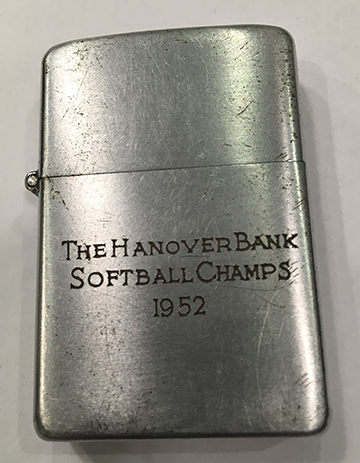
From Stephen Schaffer (2/23/21):
My father, Robert Schaffer III, played on the 1952 Hanover Bank Softball Champions team. For winning, they got this lighter. I do not know for certain what he did at the Hanover Bank. He graduated from NYU courtesy of the GI Bill following WW2. He grew up with Arthur Boddicker, who later became a VP at MHT (and retired after 48 years at the Bank). When I eventually interviewed with Artie all those years later, it was my sad duty to tell him that his childhood friend, my father, had passed away years prior to our meeting.I joined Manufacturers Hanover Bank in 1983, starting out in operations over at the CBC 605/606 group on Broadway and 41st and eventually working my way over to the trading floor at 270 Park Avenue. I started there as a retail salesman on the Commercial Paper desk, working with Bob Anczarki and Don Taggert, before moving onto trading Treasuries under Bill Pike before the Chemical merger. Subsequent to getting laid off in the Chemical merger, I continued in the treasury market brokering for Hilliard Farber, an old Chase Manhattan hand, then helped starting an off screen brokerage shop under Bill Ogden, who was a vice chairman at Chase. I couldn’t get away form the old firm even after they fired me! The last 23 years of my career were spent working for Garban/Icap/Tullet Prebon Icap. I am now retired and living in Westhampton, NY.
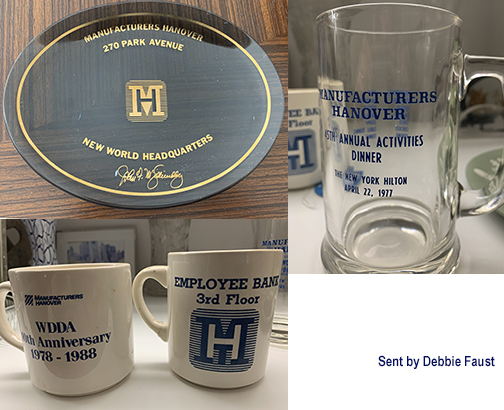
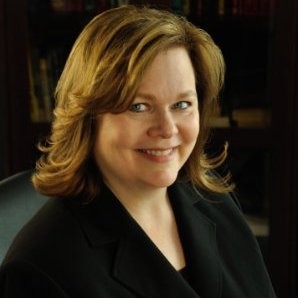
From Mary Timoney Strauch (1/14/21): I started my career in 1985 at Manny Hanny. Attached are a few photos of relics I still have in my possession. The Officer's Dining Room plate was actually purchased at a second hand shop in NYC decades ago, and yes, I paid $38 for it! In 1985, if memory serves me, John McGillicuddy was the National Chairman of the Savings Bond campaign so I am sure we all "enrolled". The beach towel was a gift for participating in the 1986 Savings Bond campaign. (I worked in Global Investor Services at 530 Fifth Avenue, 1211 Avenue of the Americas and Metrotech, and left Chase in 2006.)
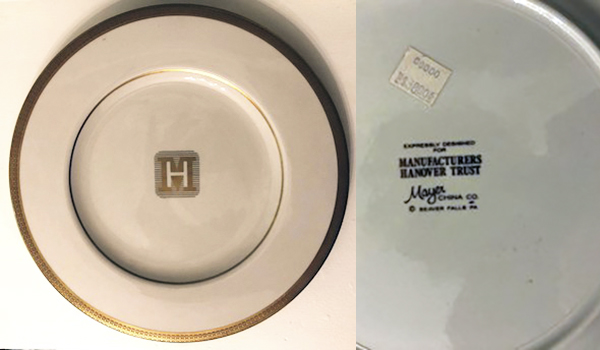
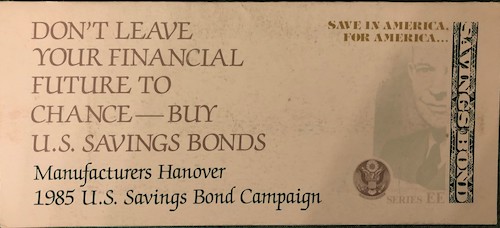
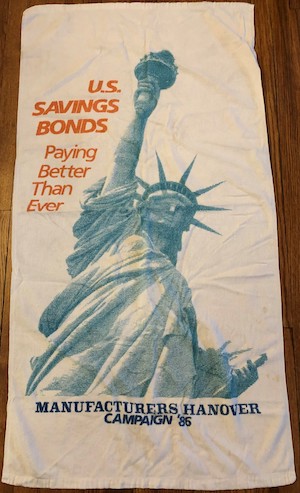
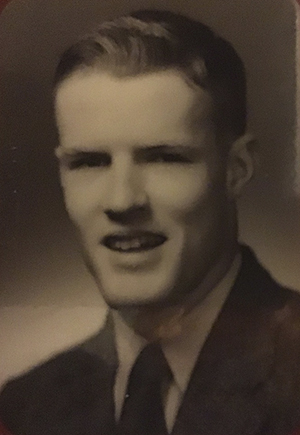
From Geoffrey Burke (1/10/21): I joined Manufacturers Hanover in November 1963 (see picture) shortly after my release from active duty with the Navy. Perhaps because the SVP in charge of personnel, John Henneman, was a former Navy admiral, participation in Reserve components was encouraged and actually subsidized. We were given full pay for two weeks training duty in addition to regular vacation pay. I remained in the active Reserve until moving to Connecticut in 1971, when the time demands became too much — but that extra pay constituted a
significant part of the down payment on our first house.
Because the Justice Department’s suit against the 1961 Manufacturers/Hanover merger was still unresolved, all departments had to contemplate “unscrambling the egg”, so our trust accounts were carried separately–and staff referred to each other as “old Hanover” or “old Manufacturers” men. And “men” was a significant term in those days of dress codes and separate duties. Adjacent to the officers’ platform on the fourth floor of 40 Wall Street was a bathroom with a “Gentlemen” sign on the door. On the other side of the floor, where the operations area was, were two bathrooms: one titled “Men” and the other “Women”.
While the pressure to wear hats was fading, the VP to whom I reported remarked on my habit of wearing blue, rather than white, shirts. One day in late summer of 1964, having spilled coffee on myself, I went over to Wanamaker’s on Broadway and changed into a blue and white striped shirt. His only comment was “interesting compromise”.
Somehow, I survived until the summer of 1995.
From Lawrence Bloom (1/10/21): I was an employee of MHT starting in 1968 who rose to AVP and dined daily in the officer dining room. That changed with the name change to Chemical Bank... gone was the Officer Dining Room. I was part of the joint venture between Chemical Bank and Mellon Bank that led to my relocation to Ridgefield Park, NJ as an employee of Chemical Mellon Shareholder Services in 1995. I was involved in more corporate and location changes before I retired in 2007 from BNY Mellon in Jersey City, NJ.; 39 years of devoted and loyal service!
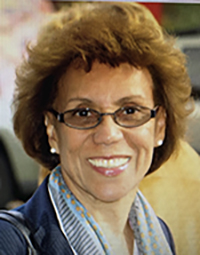
From Maria V. Trinidad (1/10/21): I came from Caguas, Puerto Rico to New York City. This is the story of my banking career from July 12, 1967, to my retirement from JPMorgan Chase in November 2007.
First of all, I thank my parents, who stressed the importance of education and their love which helped me to realize my life achievements. I also thank all my wonderful teachers from Thomas Jefferson High School who were instrumental in the start of my banking career. They were the ones who recommended going to Manufacturers Hanover Trust Bank (MHT), then located at 40 Wall Street, NYC. I was interviewed and offered a position as a typist/clerk in the Securities Collection Department. I took advantage of their tuition refund college program and obtained a college degree. Over the years I was transferred to different areas throughout the Bank, retiring 40 years later as a JPMorgan Vice President and Global Account Manager for the IT Risk Management Team.
I had wonderful management teams at MHT. They went out of their way to make sure that I was able to learn the business, and they were very happy with my work. This was a time that I was preparing to enter a rapidly changing society. I learned at an early age that many of the old ideas were being scrutinized and analyzed, and new concepts, new guidance were evolving. Women and minorities were entering the business world, and new technologies were creating a new economic system. I immediately learned that it was my duty to learn as much as I could in order to excel in this new working environment. The choices I made when I started to work at MHT determine the direction of my future. I had a burning desire to be the best worker possible so I could be successful in the business world.
After I was promoted to Typist Head, I started to look around other areas at the Bank. I had acquired sufficient wisdom and knowledge, and my networking communications with other departments and managers expanded tremendously. That initiative guided me to play a part in building my better future throughout the changes and mergers that I survived during my wonderful career. In addition, I became a volunteer to many different organizations from MHT through all the banking mergers, and I helped other workers to be proactive in all the opportunities that the banking world was offering to all of us, as women and minorities began breaking glass ceilings throughout the banking world.
On August, 22, 1983, plastic cards opened household doors across the United States; MHT debit card holders were able to get cash or check their balances at any of 3,000+ ATMs across the country. That is when I met Mr. Edward Miller, Chairman, MasterCard International.
I became a volunteer worker for MHT and encouraged others to be part of my team. At this time I was working for the Brokers Automation Dealers Department. We did United Way, IBM Management Development Team, Walk American Teamwork. We were part of Starting Diversity Groups Initiatives. We won many awards in the name of our companies.
I survived the changes and mergers throughout my wonderful career because I acted wisely and attentively. I was able to bring happiness to myself and many others, including management teams, by sharing my experiences. I also taught managers and co-workers Spanish, so they could be bilingual.
My Personal and Professional Growth has inspired many other employees to continue to invest in their own careers. I became a role model for others and was able to mentor and help others to support our communities as well as our Banking Company.
Send your stories/photos to news@chasealum.org
